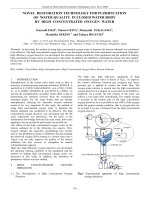Restoration literature
Bạn đang xem bản rút gọn của tài liệu. Xem và tải ngay bản đầy đủ của tài liệu tại đây (302.66 KB, 57 trang )
Restoration Literature
Lecture One:
Introduction
Time of Enormous Change
two revolutions,
a religious revolt
great strides in learning.
Great Writers Flourish
Milton
Pope
Dryden
Swift
Behn
Where Does the Term “Restoration”
Come from?
In 1649, King Charles I was executed by the
Parliament
From 1649-1660 England was ruled by the Lord High
Protector, Oliver Cromwell and Parliament.
This period is called the Interregnum
The Restoration
For a number of reasons England wanted no more of
protectorates
Asked Charles II, the executed king’s son, to come
back to England and rule.
First Stuart King
James VI and I, King of Scotland and England.
Came to the throne 1603 when his cousin, Elizabeth
I, the last Tudor monarch, died
Died 1625
Martyred King
Charles I
married Henrietta Marie de Bourbon, daughter of the
King of France
Executed January 30, 1649
Restored King
Charles II
only 19 when his father is executed
restored to the throne May 1660
died 1685
Exiled King
James II, brother of Charles II
Married first, Lady Anne Hyde
Married second, Princess Maria de Modena
Abdicated 1688
Died in Paris, 1701
England’s Only Co-regnants
Mary II and William III
Mary is the daughter of James II and Lady Anne
Hyde, Duchess of York.
William is the son of King Charles II and King
James’s sister Mary and her husband Willem II,
prince of Orange-Nassau
Mary died 1694
William died 1702
The Last Stuart Monarch
Anne, younger daughter of James II and Lady Anne
Hyde, Duchess of York.
Died childless in 1714
Passed the throne on to her cousins in the House of
Orange
from Hanover.
Simplified Reasons for Civil War
The economic interests of the urban middle class
coincided with religious (Puritan) ideology and this
conflicted with
The traditional (agrarian) economic interests of the
Crown and the allied Anglican Church.
Confused by Christianity?
If you are not up on the variations of Christianity, I
firmly suggest you look at
Fu Jen English Dept’s World Religion pages
Who are the Puritans?
A generalization, as there are wide variances in
this group.
Included the Presbyterians, Independents,
Congregationalists, Baptists, Quakers. Most of
these religions are some form of Calvinism.
Not only did the Puritans wish to “purify”
themselves, they also strove to "purify" both the
English church and society of the remnants of
"corrupt" and "unscriptural" "papist" ritual and
dogma.
What are Papists?
Derogatory term!
Papist refers to those who follow the Pope, in
other words, Roman Catholics.
For the Puritans, Roman Catholics were worse
than unbelievers.
Puritans believed that Roman Catholics were
actually following the Anti-Christ in the shape of
the Pope, and at heart, they were nothing more
than idol worshippers.
What does this mean for individuals?
In a broad sense, Puritanism represented strict
obedience to the dictates of conscience and strong
emphasis on the virtue of self-denial.
Puritanism and Art
It’s not that they didn’t like art, though they were
traditionally anti-theater (which for them represented
lying and immorality).
But art should glorify God.
One of England’s greatest poets, Milton, was a
staunch Puritan.
Puritanism and Wealth
Puritanism encouraged an essentially practical
attitude to worldly affairs.
success at business was a visible sign of God’s
blessing and approval.
You might want to look at some of Max Weber’s
writings on Puritanism and the rise of capitalism, if
you like this stuff
Where Does that Leave Art?
Art encourages contemplative virtues, which the
practical Puritan was inclined to view as unnecessary,
therefor frivolous, therefor “sinful”.
The “Inner Light”
Puritans believed that the “good life” could only be
lived by the “inner light” - the voice of God in the
heart - and to “hear” this voice it was necessary to
conduct the most scrupulous self-inquiry.
Spiritual Auto-biography
From this came a form of literature known as the
“spiritual autobiography,” which became very popular
during this period.
John Bunyan’s Grace Abounding To The Chief Of
Sinners is one of the most famous examples. (can be
found in the Norton)
Two Consequences:
Increased interest in, and understanding of, the
human heart in others as well as in the self (see
Pilgrim’s Progress)
Encouraged the sense of loneliness of the individual -
a sense supported by the growing economic
individualism of the late 17th century
Puritan Values in England
Puritanism’s influence in England peaked during
Cromwell’s rule, but it many of its principals had
become firmly entrenched in the middle class during
this period.
As a result, English and Scottish culture are heavily
influenced by the Puritan ethic.
Cavaliers vs. Roundheads
Cavaliers - nickname
Roundheads -
for the Royalist side
“Cavalier poetry” by
Lovelace and
Suckling among
others
Cavaliers are seen
as brave, graceful
and witty
nickname of the
Puritans
Seen as dull, boring
and religious
Remember, they
ultimately “lost” the
battle, so our view is
colored.
The Royalists Loose
King Charles I executed
Contemporary engraving of the
execution of Charles I. He is
already being seen as a martyr.









